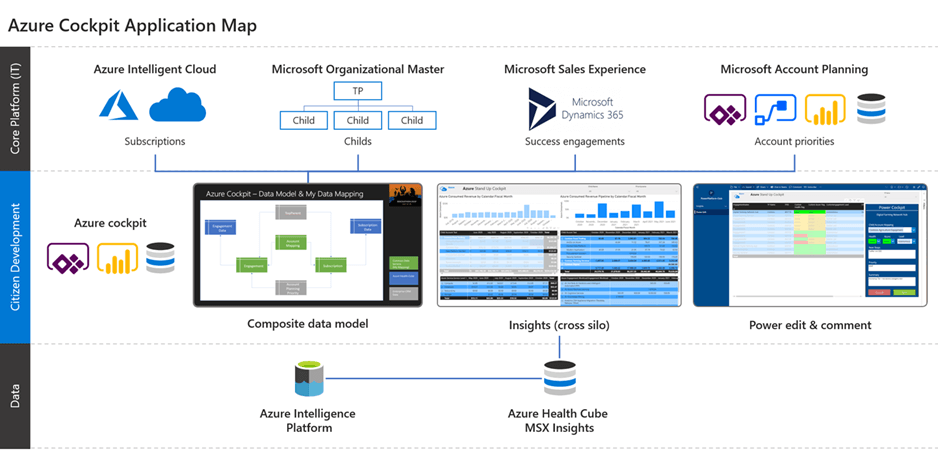 Data is great to have, but it’s only as good as our ability to digest it.
Data is great to have, but it’s only as good as our ability to digest it.
Alex Thiede, digital transformation lead for Microsoft in Western Europe and a former Microsoft Azure field seller based in Vienna, set out to talk to other Microsoft Azure sellers to discover how to help them serve their clients better.
For a multi-billion dollar business with more than 3,000 sellers, the potential for impact was huge.
– Alex Thiede, digital transformation lead
What emerged was a common pain point around exploding data. An enormous amount of customer data was being produced, but it was being siloed into different systems that never connected. Cloud Solution Architects (CSAs) and Microsoft Azure specialists would have to go into Microsoft Azure portals for customer data, Microsoft Dynamics 365 to track their customer engagements, and the Microsoft Account Planning Tool to manage account plans.
For Microsoft Azure sellers, whose mission is to help their clients be successful with their cloud experience, it was difficult to get a clear picture of how their accounts were performing. They were spending hours analyzing their data, running it through their own Microsoft Excel sheets and Microsoft Power BI reports, before finally sharing their insights with their account teams which required even more hours spent building Microsoft PowerPoint slides.
“For a multi-billion dollar business with more than 3,000 sellers, the potential for impact was huge,” Thiede says. “So how do you bring those teams together on the IT side to have a customer-centric view?”
Thiede realized that this was a great question to answer with a Hackathon project.
Thiede assembled a team that included data scientists, field sellers, security specialists, and Microsoft Power Platform developers who were all passionate about solving the problem. They set out to build a solution using Microsoft Power Platform while demonstrating how IT and sales teams could come together in a citizen developer approach.
Within two weeks, the team had come up with the S500 Azure Standup Cloud Cockpit, a tool that brought all the data together in a configurable dashboard that put the individual sellers in the pilot seat.
For Jochen van Wylick, a cloud solutions architect, Hackathon team member and the lead CSA for strategic accounts in the Netherlands, that meant there could finally be a real tool to replace all of the manual unofficial hacking they had been doing to try to layer data in a meaningful way.
Van Wylick showed the team how they were adding additional metadata to the dozens of engagements they were tracking in their CRM to stay organized, and they incorporated that capability in an automated way.
“I like the fact that Alex implemented these ideas in the Stand Up Cockpit,” van Wylick says. “I also like the fact that it will boost my productivity.”
[Learn how Microsoft has automated its revenue processing with Power Automate. Find out how Microsoft is monitoring end-to-end enterprise health with Azure.]
The Microsoft Power Platforms and the power of citizen development
The team wanted to enter the Hackathon competition with a viable product to wow the judges. So, they used the Microsoft Power Platform to create a low-code tool that proved the feasibility of the Stand Up Cockpit while demonstrating how sales and IT teams could innovate together using a citizen developer approach.
Collaborating across six different regions on three continents in the first all-virtual Hackathon, the IT team members built the application environment while leaving the user interface up to the sellers to customize as they wished.
Stefan Kummert, a senior business program manager for Microsoft’s Field App and Data Services team, built the cockpit’s components on Microsoft Power Platform. Kummert says the challenge was the ability to create composite models layering Microsoft Power BI data with Microsoft Azure data analysis. While this is in fact a new Microsoft Power Platform Power Apps feature slated for release sometime in November, it wasn’t available to them at the time of the Hackathon in July.
“So, we tried to remodel this concept, more or less,” Kummert says. “We factored what’s available out of the box with some other Power Platform building blocks, and that’s what gave us all the functionality we needed.”
Sellers could now integrate their data sources into a composite data model, add custom mapping and commenting, gain insights at the child and business unit levels, and more quickly identify issues and potential for optimizations that would serve their clients. At the end of the Hackathon, they had a working prototype using real customer data.

The team largely credits this agility to the citizen developer approach, which empowers non-developers to create applications using low-code platforms sanctioned by IT. “There’s often not enough time to create applications in the classic way,” Kummert says. “I think citizen dev is changing the picture significantly, giving us a fair chance to address the huge amount of change happening in the business environment.”
Microsoft’s 2020 Empower Employees hackathon category. With their win, they were awarded dedicated resources and sponsorship from Microsoft Digital.
Turning the dream into reality
Fresh off their Hackathon win, the team is now working on moving the app into production and getting it into the hands of Microsoft Azure sellers.
They’ll first roll it out to 10 customers, then another 100, and if it’s successful, it will be built into the core platform and scaled out across the Microsoft Sales Experience, MSX Insights, Microsoft Organizational Master, and Microsoft Account Planning programs.
This rapid prototyping and incremental rollout is a strategy targeting increased adoption–an approach that’s appreciated by program managers like Henry Ro, who maintains sales and marketing platforms for Microsoft Digital.
Without the Hackathon, it would have been harder to bring this team together. Rather than doing this just once a year, why not have it as a regular working style? It’s about the energy, the inclusive culture, and the people coming together who have real passion.
– Alex Thiede, digital transformation lead
“Projects like the Azure Cockpit really make it easy for our team and others to validate an idea and take it to fruition,” Ro says. “We’re excited about its capabilities and how we can enable it.”
For their part, Thiede and the team are already itching for another Hackathon–or at least more projects driven by the same kind of inspiration and agility.
“Without the Hackathon, it would have been harder to bring this team together,” Thiede says. “Rather than doing this just once a year, why not have it as a regular working style? It’s about the energy, the inclusive culture, and the people coming together who have real passion.”

- Learn how Microsoft has automated its revenue processing with Power Automate.
- Find out how Microsoft is monitoring end-to-end enterprise health with Azure.
Tags: Azure, Azure Compute, citizen developer, cloud, CRM, Data, Hackathon, Power Platform








